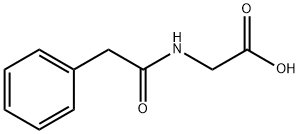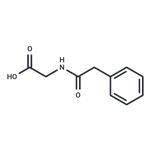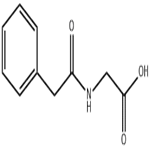Phenylacetylglycine is an acylglycine. Acylglycines are normally minor metabolites of fatty acids. However, the excretion of certain acylglycines is increased in several inborn errors of metabolism. In certain cases the measurement of these metabolites in body fluids can be used to diagnose disorders associated with mitochondrial fatty acid beta-oxidation. Acylglycines are produced through the action of glycine N-acyltransferase (EC 2.3.1.13) which is an enzyme th at catalyzes the chemical reaction: acyl-CoA + glycine ↔ CoA + N-acylglycine. Phenylacetylglycine or PAG is a glycine conjugate of phenylacetic acid. Phenylacetic acid may arise from exposure to styrene (plastic) or through the consumption of fruits and vegetables. Phenylacetic acid is used in some perfumes, possessing a honey-like odour in low concentrations, and is also used in penicillin G production. PAG is a putative biomarker of phospholipidosis. Urinary PAG is elevated in animals exhibiting abnormal phospholipid accumulation in many tissues and may thus be useful as a surrogate biomarker for phospholipidosis. The presence of phenylacetylglycine in urine has been confirmed for dogs, rats and mice. However, the presence of this compound in human urine is controversial. GC-MS studies have not found this compound while NMR studies claimed to have identified it , It appears th at phenylacetylglycine may sometimes be mistaken for phenylacetylglutamine via NMR.



